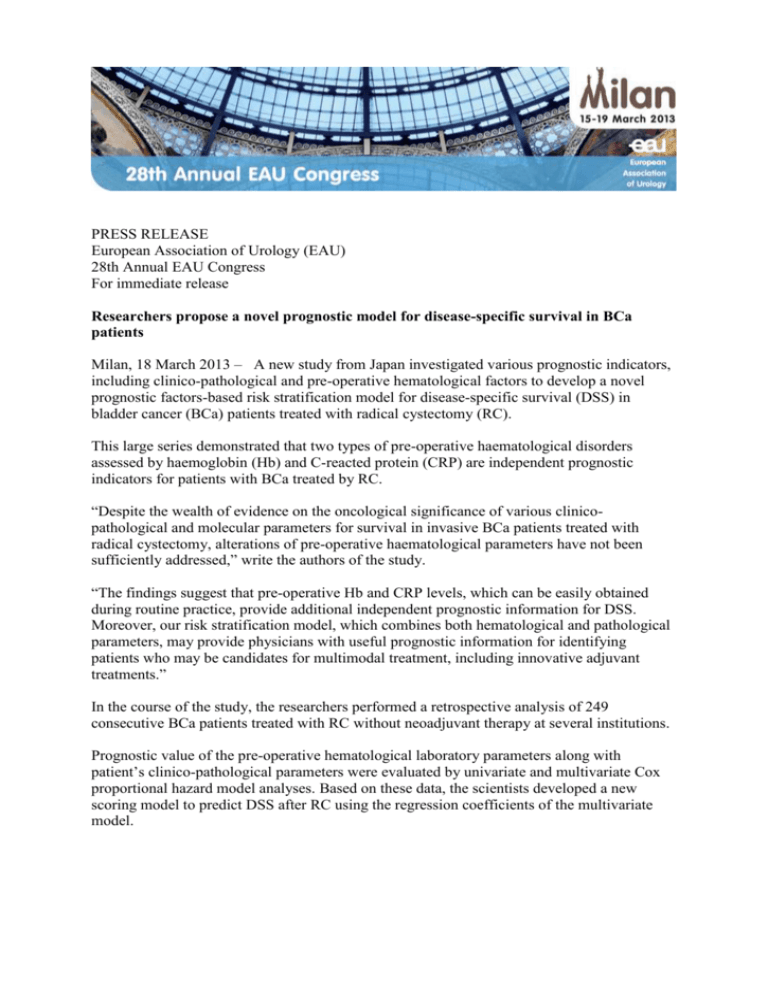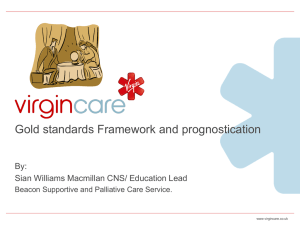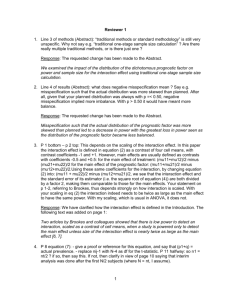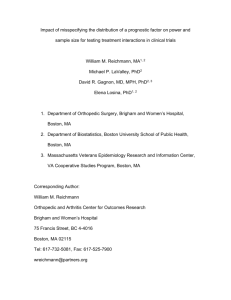press release - EAU Annual Congress
advertisement

PRESS RELEASE European Association of Urology (EAU) 28th Annual EAU Congress For immediate release Researchers propose a novel prognostic model for disease-specific survival in BCa patients Milan, 18 March 2013 – A new study from Japan investigated various prognostic indicators, including clinico-pathological and pre-operative hematological factors to develop a novel prognostic factors-based risk stratification model for disease-specific survival (DSS) in bladder cancer (BCa) patients treated with radical cystectomy (RC). This large series demonstrated that two types of pre-operative haematological disorders assessed by haemoglobin (Hb) and C-reacted protein (CRP) are independent prognostic indicators for patients with BCa treated by RC. “Despite the wealth of evidence on the oncological significance of various clinicopathological and molecular parameters for survival in invasive BCa patients treated with radical cystectomy, alterations of pre-operative haematological parameters have not been sufficiently addressed,” write the authors of the study. “The findings suggest that pre-operative Hb and CRP levels, which can be easily obtained during routine practice, provide additional independent prognostic information for DSS. Moreover, our risk stratification model, which combines both hematological and pathological parameters, may provide physicians with useful prognostic information for identifying patients who may be candidates for multimodal treatment, including innovative adjuvant treatments.” In the course of the study, the researchers performed a retrospective analysis of 249 consecutive BCa patients treated with RC without neoadjuvant therapy at several institutions. Prognostic value of the pre-operative hematological laboratory parameters along with patient’s clinico-pathological parameters were evaluated by univariate and multivariate Cox proportional hazard model analyses. Based on these data, the scientists developed a new scoring model to predict DSS after RC using the regression coefficients of the multivariate model. One-, 3-, and 5-year DSS rates were 89.1%, 69.3%, and 62.7%, respectively. In multivariate analysis, pre-operative values of low hemoglobin (Hb) (< 10g /dL) and high C-reacted protein (CRP) (> 0.5 mg / dL), pathological T stage (≥ pT3a), lympho-vascular invasion (LVI) and positive surgical margin (PSM) status were independent factors for predicting poor prognosis. The score was calculated as 2 (if PSM) + 2 (Hb < 10g /dL) + 1 (if ≥ pT3a) + 1 (if LVI) + 1 (CRP > 0.5 mg / dL) and 0 (if otherwise). The 4-year DSS in patients with a score in the ranges 0-1 (low-risk), 2-3 (intermediate-risk) and 4-7 (high-risk) was 83.4%, 48.8% and 5.9%, respectively All differences in DSS between subgroups were P < 0.0001 (Figure 1). Figure 1: ### For further information please contact: Ivanka Moerkerken i.moerkerken@uroweb.org Tel: +31 (0) 26 389 0680 Notes to editors About the European Association of Urology The EAU represents the leading authority within Europe on urological practice, research and education. Over 16,000 medical professionals have joined its ranks and help to create forward-looking solutions for continuous improvement, professional growth and knowledge sharing. The EAU delivers training, stimulates research and broadcasts information. The EAU’s scientific publications encourage discussion and its expert recommendations guide urologists in their every-day practice. Reference T. Sejima, et al., “The prognostic impact of pre-operative hematological disorders and a risk stratification model in bladder cancer patients treated with radical cystectomy,” Abstract Nr: 925; 28th Annual EAU Congress, 15 to 19 March 2013; Milan, Italy.







